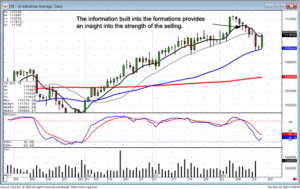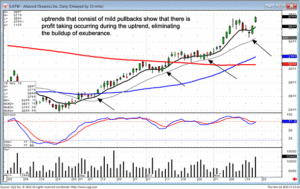The expression, stock market correction, sounds like something was wrong and is now being fixed. Depending upon the point of view of traders and investors involved in the stock market this is sometimes the case. In general a stock market correction is a drop in stock price, usually after a rapid and/or prolonged rise. Typically a decline of as little as five percent and a much as twenty percent in the Dow Jones Industrial Average is the benchmark for a stock market correction. The decline in stock prices happens over a brief period. When stocks decline over a long period it is referred to as a bear market. Unlike bear markets stock market corrections are secondary market trends. A stock market correction is a market reversal superimposed on a steadily rising bull market. Using technical analysis tools such as Candlestick pattern formations traders are able to distinguish between a stock market correction and the start of a persistently downward, bear, market.
Why does a stock market correction occur? That is the part about something being wrong and needing to be fixed. In both long term investing and in day trading it is important to keep an eye on intrinsic stock value. Stock prices may go up and give the impression that there is no end in sight. When this happens stocks become “over bought.” Latecomers to a market rally will try to buy in with the hope of obtaining profits before the trend reverses. Those who bought stock early in a market rally will start to worry when the price to earnings ratio of their stock rises too high to be supportable. One quarterly report with flat profits in key industries will commonly spook many investors who will rush to the exits, selling stock as they go. Likewise smart investors will simply take a little profit as the market heats up. In either case the selling pressure on the market drives prices down.
The trader or investor who uses Japanese Candlestick analysis will commonly see this coming and be able to sell stock or sell short just before a market reversal. Likewise, when the stock market correction happens the savvy trader reading Candlestick patterns can see when a correction has run its course and will often be able to buy stock to reverse short selling or even buy more stock as the market heads upwards again.
When the stock market moves up or down dramatically it is critical to have technical analysis tools such as Candlestick charting techniques on your side. The psychology of trading and the psychology of investing are such that it is easy to become fearful or to become greedy when what the person needs to do is thoughtfully analyze the stock market signals in order to profitably buy or sell stock, engage in buying calls or buying puts, or simply sit tight while the panic subsides. Seeing a stock market correction for what it is will allow the investor who was caught by surprise to ride out the storm and regain his or her stock value in a short time. Seeing a stock market correction coming will allow the same investor to buy puts on the same stock. When the price corrects the investor will execute the options contract and get the strike price for the stock. Afterwards he or she can repurchase the same stock at the now lower price spot price and resume a comfortable ride in the resuming bull market.
Market Direction
How do you tell if a trend is merely correcting or had a full-scale reversal? This is the question many investors find debilitating as far as taking profits. Not knowing how to recognize a profit-taking pullback versus a full-scale reversal makes it difficult for most investors to close out a long position. This leads to one of the most prominent fears most investors encounter. “Do I take profits here or hold on in case the price turns around and heads higher?”
This problem is dramatically diminished if one can identify what the general market trend is doing. As seen in the Dow chart, there were signs that indicated a high probability that profit-taking would be occurring. After the strong bullish candle moved the Dow away from the T-line, while the stochastics were indicating overbought conditions, the appearance of candlestick sell signals produced a high probability scenario that it was time to take profits. However, many investors fear that if they took profits at that level, they would have been fooled out of good positions. This fear stems from the fact that up until not too many years ago, most investors had no indicators they could study to show when it was time to be in or out of positions. Most of the time, closing a position had more to do with a stockbroker recommending it was time to take profits or in other words, it was time to produce some commissions.

DOW
With the whole array of investment indicators at our fingertips, an investor can make much better assessments as to whether merely profit-taking is occurring or the sellers are trying to bail out of the market. Note how the Dow pulled back with indecisive candle formations. This illustrated there was no ‘convincing’ strength to get out of the market. Price patterns also become an advantageous tool. Knowing what should result from the development of a price pattern allows an investor to make a much better decision for when to get back into a trade.
Additionally, there are a number of subtle indicators that tell an investor what the general investor sentiment is during specific market conditions. Witnessing a good number of stocks continuing to trade positive in spite of the market moving down provides important information. Buyers are not vacating the market in a panic. When a good percentage of stocks are continuing higher as the market in general is heading lower, it can be assumed the selling has not turned into a mad rush.
When up trends are not producing exuberant buying assessments from the so-called professionals, this also diminishes the panic factor when the market moves south for a few days. An uptrend can produce visual evidence with a strong up moves but mild pullbacks. As seen in the ATW chart, the uptrend maintains good strength when there is profit-taking along the way. This can be seen with much more clarity when using candlestick charts.

ATW
Learn how to use the information built into candlestick charts and you will be able to assess price movement with the same expertise as professionals who have been doing it for years. There is an immense amount of information built into candlestick charts. When you utilize that information for establishing trade positions, you put the probabilities are greatly in your favor.
Chat session tonight at 8 PM
Good Investing,
The Candlestick Forum Team
Speak Your Mind